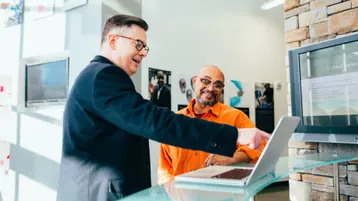
Engaged employees can help make an organization more successful
Employee engagement may not be the easiest topic of discussion, but the potential results are worth the effort. We’ll cover several methods to build employee engagement in your business, along with other considerations to maximize opportunity.
Here's what you need to know:
- People whose skills are suited for the job and who are at the right point in their career for the role will naturally be more engaged in and enthusiastic about their work
- Chart out a clear, purposeful mission for your small business at large as well as the individual teams that comprise it
- Take a look at what tools you can provide to your employees to help them succeed
- Not sure what it is that your employees need? Survey your employees to find out
- Recognize employees’ work; make sure recognition and rewards come from not only direct managers and supervisors, but from peers and teammates as well
Stress is through the roof these days. Layoffs and cutbacks are happening left and right with a backdrop of a global pandemic and an economic downturn. From employees worrying about job security and getting sick themselves, to kids learning remotely from home and to supporting older family members who still aren’t able to leave the house, everyone has a lot going on.
When there are life stressors floating around, it’s easy to see how employee enthusiasm and engagement can drop. Chances are you’re spending a good chunk of your days thinking about the future of your small business rather than focusing on the tasks at hand, right? So too are your employees.
However, all is not lost. There are things you can do to boost employee engagement and enthusiasm even during these trying times. While the key is to figure out what best meets the unique needs of your small business and roster of employees, these tips and tricks are a good jumping off point.
Hire the right people for the job
If you hire and retain people whose skills are suited for the job and who are at the right point in their career for the role, they’ll naturally be more engaged in and enthusiastic about the work they’re doing. Not only does appropriate hiring help keep employees focused and productive, it reduces the costs you have to spend to rehire and retrain people when mismatched hires leave for a better fit.
Provide a clear purpose and mission
This is especially true when it comes to younger generations like millennials and Gen Z, but most people want to work for more than just a paycheck — they want to work towards something bigger than themselves. Many employees want to know that the 40 plus hours a week they put into their work matters. While you can’t help individual employees figure out what matters to them personally, what you can do is chart out a clear, purposeful mission for your small business at large as well as the individual teams that comprise it.
Whether your mission is a bit outdated and it’s time to revamp it for today’s era, or you just never got around to concretely setting one, make sure that you do what you can to show how the work that your company does makes a difference in the world.
Give them the tools they need to succeed
Employee engagement and enthusiasm can plummet when you don’t give your staff the proper tools that they need to do their job efficiently, effectively, and well. In the remote work times that COVID-19 has sparked, there’s a new need for virtual tools that most teams didn’t need when they were working beside each other in an office 5 days a week.
Some tools you can provide are:
- Increased digital storage
- A stipend for a beefed up home internet connection
- An investment in digital communication software
Take a look at what you can provide to your employees to help them succeed since few things will ruin engagement more than being set up to fail.
Consistently conduct employee surveys
Not sure what it is that your employees need? Well then, it’s time for you to survey your employees. The best thing is that you can design and send out a survey to gather whatever information you’re looking for. You can ask employees about the tools and professional development opportunities they want, how working remotely is going for them, and so much in between.
Focus on rewarding and recognizing their work
We’ve all been in a job where our hard, earnest efforts went practically unrecognized. It’s hard to stay jazzed about your work when it feels like it doesn’t matter. Luckily, this problem can quickly be rectified.
To recognize employees’ work, you can:
- Make sure to tell your employees directly when they’ve done a good job
- Be clear in companywide emails about the impact that teams are having on the business’s goals
- Start an old-fashioned employee of the month program
Remember — a little effort goes a long way.
Coach your company’s managers and leaders
That said, recognition can (and should) come from more than one place. Of course recognition from the boss feels extra special, but your employees should be getting consistent recognition and rewards from not only their direct managers and supervisors, but from their peers and teammates as well.
You can formalize this in official 360 review processes that require praise alongside constructive criticism, but it can also come in informal ways as well through ad hoc conversations. The key is to ensure that you’ve given your business’s managers and other leaders the training and coaching they need to be able to recognize good work when they see it, call it out effectively and appropriately, and encourage those under their charge to do the same for their peers and teammates.
Why You Should Use Gamification for Employee Engagement and Motivation
Games in the workplace can help employees improve their skill set, beat their own statistics, challenge one another, and be recognized for their achievements.
Keeping employees motivated and engaged can be a full-time job. When workers are engaged their workday flies by, their enthusiasm is infectious, their customers are well cared for, and the company thrives. Anything an organization can do to boost engagement and motivation is worth the effort. The challenge is to find tools that motivate employees in a manner they enjoy and even seek out.
Gamification may be the answer. This new trend in engagement uses games, either digital or old-fashioned company contests, to recognize employees while they work. Gamification lets workers celebrate milestones, earn badges, up their status, or score rewards. You can set them up to help workers improve their skill set, beat their own statistics, or challenge one another. There are endless possibilities for gamification — limited only by your (and your employee’s) imagination.
Does gamification work?
Gamification works because it uses positive feedback to increase employee motivation. You may not be available to give each worker a pat on the back when they accomplish a task or reach a milestone, but gamification can. It’s also available for breaking down complex tasks into smaller, more easily achievable sections that help employees complete projects. You can use it to reward smaller accomplishments, as well. Gamification helps employees get excited about even the most mundane task because there’s a reward for completion.
Studies show gamification boosts engagement in many ways. A survey from Talent LMS found 89% of workers felt gamification made them feel more productive: 88% said it made them happier at work. Almost 9 in 10 workers said when a specific task is gamified, they feel more competitive and more eager to complete it.
Gamification helps with wellness, too. A survey from eLearning Industry found 71% of workers believed it helps increase their energy levels on the job: 66% say it reduces stress levels. We’re hard-wired to seek out rewards for our efforts — a “good job” from parents encouraged us learn to do almost everything. On the job, your reward is your paycheck, but you still want acknowledgement and appreciation between paydays. Gamification steps in to provide those: at each individual employee’s pace they receive recognition for their achievements, no matter how basic or complex.
For businesses, a survey from Zippia found 27% of workers say gamification inspires them to be more productive, while 20% say it helps them stay focused and avoid distractions at work. Gamification seems to address virtually every employee engagement need — and for business, engagement pays dividends.
Ways to gamify your workplace
Companies can set up gamification programs that are basic or sophisticated. They can structure them in-house or turn to digital solutions. The key is to target areas that will entice and engage workers. Make recognition simple — with easy initiatives and milestones to get employees started on the program. As they advance through the game, things can get a bit more challenging. Begin with steps that are fun and easy to achieve and leave them wanting more.
Gamify new hire orientation: staffers earn points and rewards for completing training sessions, reading orientation materials, submitting paperwork, etc. You can gamify getting to work on time every day: working overtime or helping out with non-scheduled shifts. Employees may appreciate creating a game for their most rote tasks — making completion an achievement rather than another boring duty. Any task that can be completed and verified can be gamified.
Ways to recognize and reward
Set up games that provide immediate gratification and lead to bigger and better rewards. Employees will be pleased to get a quick pat on the back, and that will inspire them to keep “playing” the game and working harder. There are many types of programs, or you can create one of your own. Here are some to consider.
Milestone rewards
Milestone rewards:
- Celebrate anniversaries
- Help employees learn and repeat new behaviors or procedures
- Reward them for completing existing tasks
Have the employee (or manager) check in when the task is completed to earn a reward. The rewards can be badges, points, or other measurables employees can stockpile to cash in later or redeem immediately. Small tokens like company swag can be initial rewards; larger items can be earned with more points.
Leaderboards
Many companies use leaderboards to track sales, but you can extend them beyond revenue competitions. Departments that meet or exceed safety protocols can participate. Imagine going beyond the “xx days without an accident” posters with rewards for employees who take safety seriously. These individual and group efforts can reap group rewards — like a pizza lunch for the one or all when they prioritize safety.
For example, you can track number of:
- Customers served
- Burgers flipped
- Items restocked on shelves.
Anything that’s measurable become a competition either with other staff members or as employees beat their own “personal best” records.






